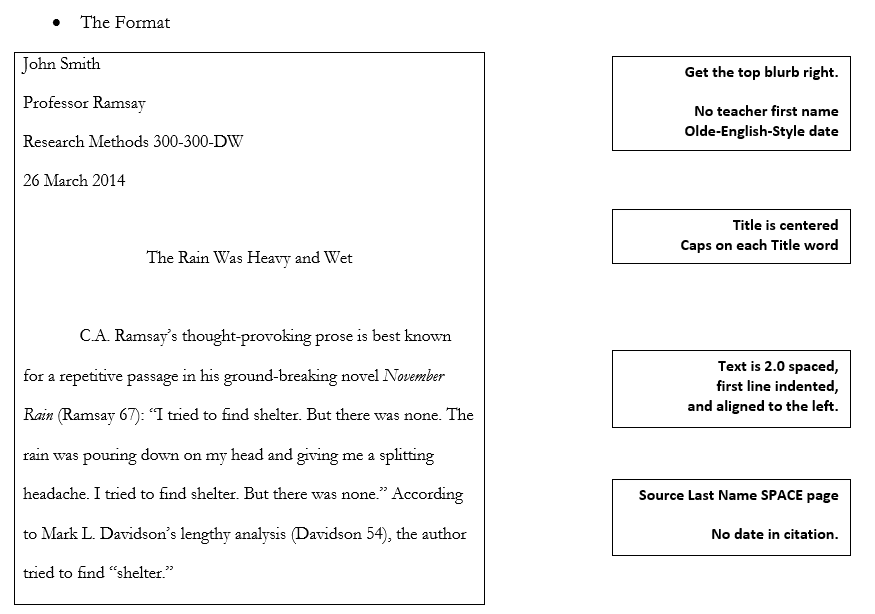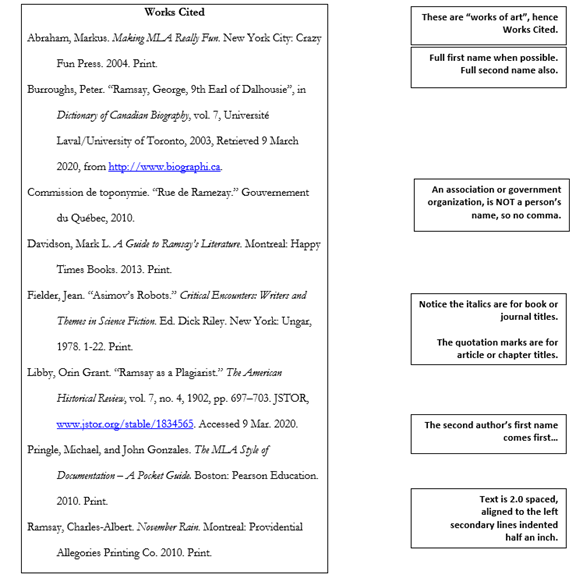MLA Style
Why Should I Care?
Some journals (and academics in that same field) use the MLA style, which is useful to know. Many teachers in college and university will expect papers to be produced using the MLA style.
The Basics
MLA stands for Modern Literature Association. This association of English literature professors across thousands of universities share a common style for the publishing of papers, which are usually an analysis of works of fiction, such as novels, plays, or poetry. MLA publishes several journals including the flagship PMLA, the Publications of the Modern Language Association.
For students, the format is relatively short, since there is not a cover page. The details of the paper are presented in a concise block in the top left corner of the first page.
This said, academics who publish in MLA journals must abide by blind peer review. This means their papers must have a cover page and there will not be any references to the author's identity in the text. MLA follows the same rules as their publishing partner, Cambridge University Press.
The style is also used by many historians, anthropologists, and many other disciplines in the humanities. If the text is not fiction, there is a specific way of presenting for citations (AUTHOR PAGE).
Here is the complete set of guidelines published by Dawson College for the MLA style. http://www.dawsoncollege.qc.ca/academic-skills-centre/handouts/
The Format
- In the top right header space,
- In the top left corner, four lines, single space,
- Citations include Last Name and Page, in parenthesis.
Dos
- Olde-English style date
- Title is centered
- Caps on each Title word
- Text is 2.0 spaced, first line indented, and aligned to the left.
Don'ts
- Teacher First Name
- Modern date with comma
- Cover page
- Use bold
- Page with comma
Here are some variations of citations in MLA style.
Version 1 - quote
According to a lengthy analysis of Ramsay's work (Davidson 54), the author tried to find “shelter.”
Version 2 - quote
Davidson provides a lengthy analysis of Ramsay's work. He believes Ramsay was trying to "find shelter” (54).
Version 3 - paraphrase
Davidson, based on a lengthy analysis of Ramsay's work, believes Ramsay was trying to find shelter (54).
When to use et al. ?
For articles with three or more authors, you can shorten the citation by using the latin phrase "et al." which is short for et alli. For example, using the article below, the citation looks like this:
According to Allcott et. al. (203), many social scientists believe that governments should tax sweet drinks.
Works Cited
Allcott, Hunt et al. ''Should We Tax Sugar-Sweetened Beverages? An Overview of Theory and Evidence.'' The Journal of Economic Perspectives. vol 33, number 3, 2019, pp. 202-227. JSTOR. https://www.jstor.org/stable/26732328. Accessed 15 June 2021.
The MLA style allows for et al. in the Works Cited (bibliography). In this case, the authors Benjamin B. Lockwood, and Dmitry Taubinsky are never cited or referenced.
The Bibliography
- The documents are often “works of art”, hence the title Works Cited.
Last Name, First Name. Book Title. Publishing Company. YYYY.
Last Name, First Name. ''Article Title.'' Journal title, vol. 1, number 1, YYYY, pp 1-2.
Dos
- Full Last name, then full First Name when known
- Alphabetical order
- Text is 2.0 spaced, aligned to the left, secondary lines indented half an inch
- Italics for book title or journal titles
- Quotation marks are for article or chapter titles
- For 2 more authors, the last author's name is in the order First Name Last Name
- Include the database and retrieval date if the document is from an online source
- Include the url address if the document is from a website
- If the author is unknown, use the organization as the author, for the bibliography and the text citations
Don'ts
- If using the organization's name as author, do not split the name with a comma
- Use & (ampersand)
- Use parenthesis for the date
- Forget the hanging indent
- Change the order of the authors within a publication
- Don't mistake an Editor for a chapter author



No Comments